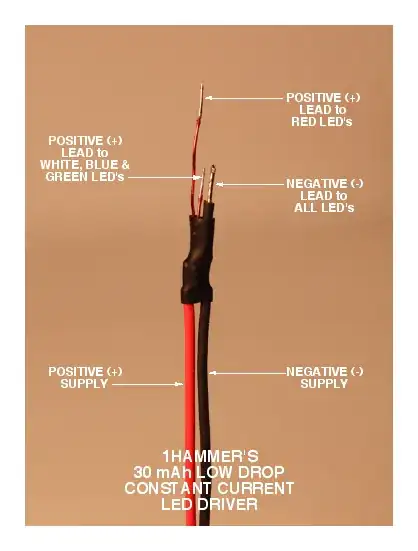While the inventor has made certain claims in their post, the vagueness and errors in terminology used indicate a possibility that the claims are not necessarily all tried and tested.
Specifically: The phrase "takes the 240mAh and 4.2 V of the LiPo down to a constant 3.0V @ 30mAh for ..." is clearly more sales-speak than veracity.
- One doesn't regulate capacity (mAh) down to anything, just current (mA).
- For a constant current driver other than a switching driver, the output voltage will not be fixed to 3.0V or whatever, it would regulate itself precisely to the forward voltage of the LED connected to it.
It thus appears that the description is of a switching current regulator, such as the Supertex HV9923 3-Pin Switch-Mode LED Lamp Driver IC. This is not necessarily the specific part used, but it would work for the purpose, with a few additional components. The size of the circuit can be made smaller than the heat shrink covered package in the question.
To take this even further, the Fairchild FAN5616 High-Efficiency Constant-Current LED Driver can actually use input voltages lower than the LED's forward voltage, and provide 3 channels of regulated drive current (up to 40 mA each), at efficiency of up to 90%. The device has an internal charge pump that raises the voltage by 1x to 2x. No personal experience on this part, though.
If one takes the inventor's claims with a bit of skepticism, a suitable alternative component is the SuperTex CL330 3-Channel 30mA Linear LED Driver, which can be used to sink a constant 30 mA per channel using just one additional component, a 100 nF capacitor. Resultant size would be minuscule.
If one limits the current to 25 mA instead of 30, an even smaller and simpler, single component 2 terminal device alternative is the SuperTex CL25, a tiny TO-243AA (SOT-89) 1.6 x 4.25 x 2.6 mm component. The efficiency of switching is lost, but the advantage is a single component in the current path, hence either source or sink, and no support components needed. There may be 30 mA equivalents available, I am not aware of them.
For all the Supertex parts mentioned, they are very generous in their sampling: They sent out a pack of 10 to 20 pieces each, for the components mentioned above as well as the CL220 and a few others, against a request for just 5 pieces of the CL25 for an evaluation.
I don't have personal experience with the Fairchild device and cannot vouch for it. They do not send out samples to my geography for some reason, they do not sell many of their LED regulation parts here, and local distributors do not carry the part.
